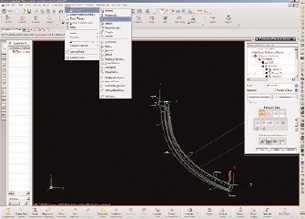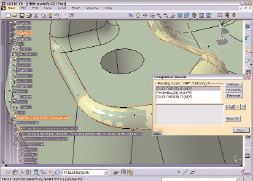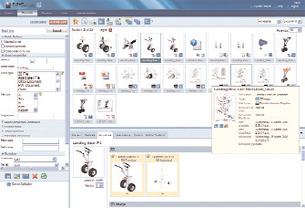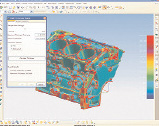A State of Continuous Improvement
In spite of collaboration challenges and waste in product development, significant progress is being made in interoperability.
Latest News
August 1, 2008
By David Prawel
 In the Datakit PMI module for NX, links to geometry and all FDT entities are supported. |
Without a doubt, the most powerful asset any company has in its competitive arsenal is its people. And the biggest challenge in deploying this awesome force is getting people to work together effectively, engaging many brains in a common direction so they can innovate bold new products. It takes people working together — global collaboration — to innovate. Yet global collaboration continues to be an area in great need of improvement.
People can’t collaborate if they can’t share data. It is the interoperability of product data and processes throughout the product lifecycle that enables global collaboration. Poor interoperability remains the single largest source of waste in product development.
Companies involved in lean initiatives must consider the cost of “waste” in their CAD departments. The majority of managers have no idea that their MCAD users are typically wasting 50 percent of their time fixing translation errors or recreating lost or corrupt data, instead of creating new products or adding value to existing products.
Two of the main sources of waste in engineering are time spent fixing poor CAD data, caused by poor interoperability between CAD systems or even different versions of the same CAD system, and time spent figuring out CAD data created by someone else, the result of poor CAD process standardization.
 The Completion Wizard identifies issues that require resolution and guides users through the completion process. |
Progress in Interoperability
The good news is that progress is being made in the quest for fully functional interoperability. STEP AP203 Second Edition (E2) is officially available for implementation this year. This release has been heralded because E2 provides many long-awaited improvements, the most important being support for product manufacturing information (PMI) such as dimensions and tolerances in accordance with ANSI Y14.41.
Another important trend is the increasing demand for fully featured product models. Huge investments are being made in capturing product knowledge in digital product models. And executives are realizing the huge value “trapped” in these data and the business case for unlocking it and making it available to a greater community of stakeholders, both inside their companies and throughout their global extended supply chains.
Though not all collaborations require access to the full product knowledge, most can benefit from some form of it. Proficiency, Inc. is making excellent progress in this domain and continues to advance these technologies. It is helping companies unlock and migrate a majority of their product knowledge between different CAD environments, and different versions of the same CAD environment, for example, CATIA V4 to V5.
 Right Hemisphere’s Deep Access portal product provides enterprise-wide access to product data. |
Areas of Growth
However, product knowledge must be safe and secure, and progress has been made in this area as well. Adobe, for example, provides enterprise-class digital rights management that lets users tightly control access to various levels of data content, time frame, and redistribution.
The emergence (or reemergence) of direct geometry editing is a significant trend in the last year. Despite progress in feature-based interoperability, most 3D data exchanges involve “dumb” or explicit (e.g., BREP) solid models. Direct editing is particularly useful for downstream applications that need to work with CAD data from designers. Kubotek, for example, has developed some powerful tools to add features and intelligence back into an explicit solid model, and to validate the results. This is exciting for the many users of STEP solids and other BREP models, which have lost their features, history, and other product knowledge.
Siemens PLM Software NX5, Solidworks 2008, and SpaceClaim are also now providing direct geometry-editing capabilities. PTC this year acquired CoCreate, a long-time player in direct geometry editing. And Dassault Systemes just announced 3DLive Shape, which apparently provides both parametric history-based and freeform modeling approaches. With all the recent activity, it’s likely this modeling approach is here to stay.
Another notable area of growth and improvement in interoperability is the secure access and use of 3D data by vastly more people in the extended global organization. Recent advancements in lightweight 3D, such as Adobe Acrobat 3D, greatly expand the availability and usefulness of digital product data throughout the extended engineering factory, value chain, and supply chain.
 Siemens PLM Software Synergy automatesand optimizes processes based on JT format. |
The JT format from Siemens PLM Software is also quite popular, and is gaining momentum recently with the acquisition of UGS by Siemens.
Dassault Systemes’ 3DXML 3D data format is a powerful, lightweight 3D format that is integrated through many of Dassault’s products. 3DXML leverages the highly compressible XVL format from Lattice Technology. Last year, Dassault announced 3DLive, its next generation online 3D collaboration platform based on 3DXML. And earlier this year, capitalizing on the 3DLive technology platform, Dassault announced 3DVIA. By applying existing technologies in new ways, the company has taken a first big step toward a new way to collaborate with 3D product information.
CAD Process Standardization
One of the biggest barriers to effective interoperability — and a hidden source of waste in engineering — is the way people communicate design data with others. Most companies have experienced CAD designers who have developed their favorite best practices, but investigation consistently reveals that more than 50 percent of design and engineering time is consumed in non value-added activities (from a lean perspective) such as figuring out other users’ CAD models, or repairing (often recreating) CAD models.
Remarkably few companies have standardized their design methodologies so all designers are using the same design principles, making it easier for their models to be shared and understood by fellow designers and engineers.
These hidden sources of waste also impede reuse of 3D product data. Due to lack of standard design methods, it is often easier for CAD users to create new designs than try to use previous work. Delphi Steering developed and standardized its Lean Design Methodology (LDM). Delphi now makes LDM available to third parties through training classes, much like Six Sigma methodology is available from different service providers worldwide.
Many new developments are under way, pushing interoperability solutions into new frontiers, while significant improvements in tools and solutions that are already known and trusted are reducing the tendency of poor interoperability to bog down the business of manufacturing, every day.
More Info:
Adobe
San Jose, CA
adobe.com
CoCreate
Sindelfingen, Germany
cocreate.com
Dassault Systemes
Paris, France
3ds.com
Delphi
Troy, MI
delphi.com/ddm
Kubotek USA
Marlborough, MA
kubotekusa.com
Lattice Technology
San Francisco, CA
lattice3D.com
PTC
Needham, MA
ptc.com
Proficiency Inc.
Marlborough, MA
proficiency.com
Siemens PLM Software
Plano, TX
plm.automation.siemens.com
SolidWorks
Concord, MA
solidworks.com
SpaceClaim Corporation
Concord, MA
spaceclaim.com
David Prawel is founder and president of Longview Advisors, Inc. (longviewadvisors.com), a global consulting firm focusing on 3D and CAD software business and applications in the manufacturing industry. You can send e-mail about this article to [email protected].
Subscribe to our FREE magazine, FREE email newsletters or both!
Latest News
About the Author
DE’s editors contribute news and new product announcements to Digital Engineering.
Press releases may be sent to them via [email protected].






